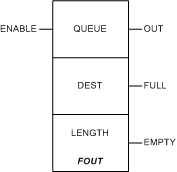|
|
(Original Document)
|
|
Name in LL984 Editor
|
Function Block Name
|
|---|---|
|
name of legacy 984 instruction
|
name in other tools and editors like:
|
 |
 |


|
Input Pin
|
Name
|
Data Type
|
Address Range
|
Meaning
|
|---|---|---|---|---|
|
Top
|
ENABLE
|
–
|
OFF to ON initiates the operation.
|
|
Node
|
Node Type
|
Name
|
Data Type
|
Address Range
|
Meaning
|
|---|---|---|---|---|---|
|
Top
|
IN
|
QUEUE
|
ANY_ARRAY_UINT
|
%MW
|
The queue pointer followed by the queue array declared as ARRAY[1..(1+LENGTH] OF UINT
(1+LENGTH is represented as a constant.
The value from the end of the queue - at the top position - is the value to be read out into the destination.
|
|
Middle
|
IN/OUT
|
DEST
|
ANY_ARRAY_UINT or ANY_ARRAY_EBOOL
|
%M, %MW
|
The destination data to be entered into the queue. The source can be a single word of type UINT or an ARRAY[1..16] OF BOOL.
|
|
Bottom
|
IN
|
LENGTH
|
UINT
|
1...100
|
The number of words to be included in the queue.
Valid range: 1 to 100.
|
|
Output Pin
|
Name
|
Data Type
|
Address Range
|
Meaning
|
|---|---|---|---|---|
|
Top
|
OUT
|
BOOL
|
–
|
ON indicates the operation succeeded. (Echoes the status of the ENABLE input).
|
|
Middle
|
FULL
|
BOOL
|
–
|
ON indicates the queue is full.
|
|
Bottom
|
EMPTY
|
BOOL
|
–
|
ON indicates the queue is empty.
|